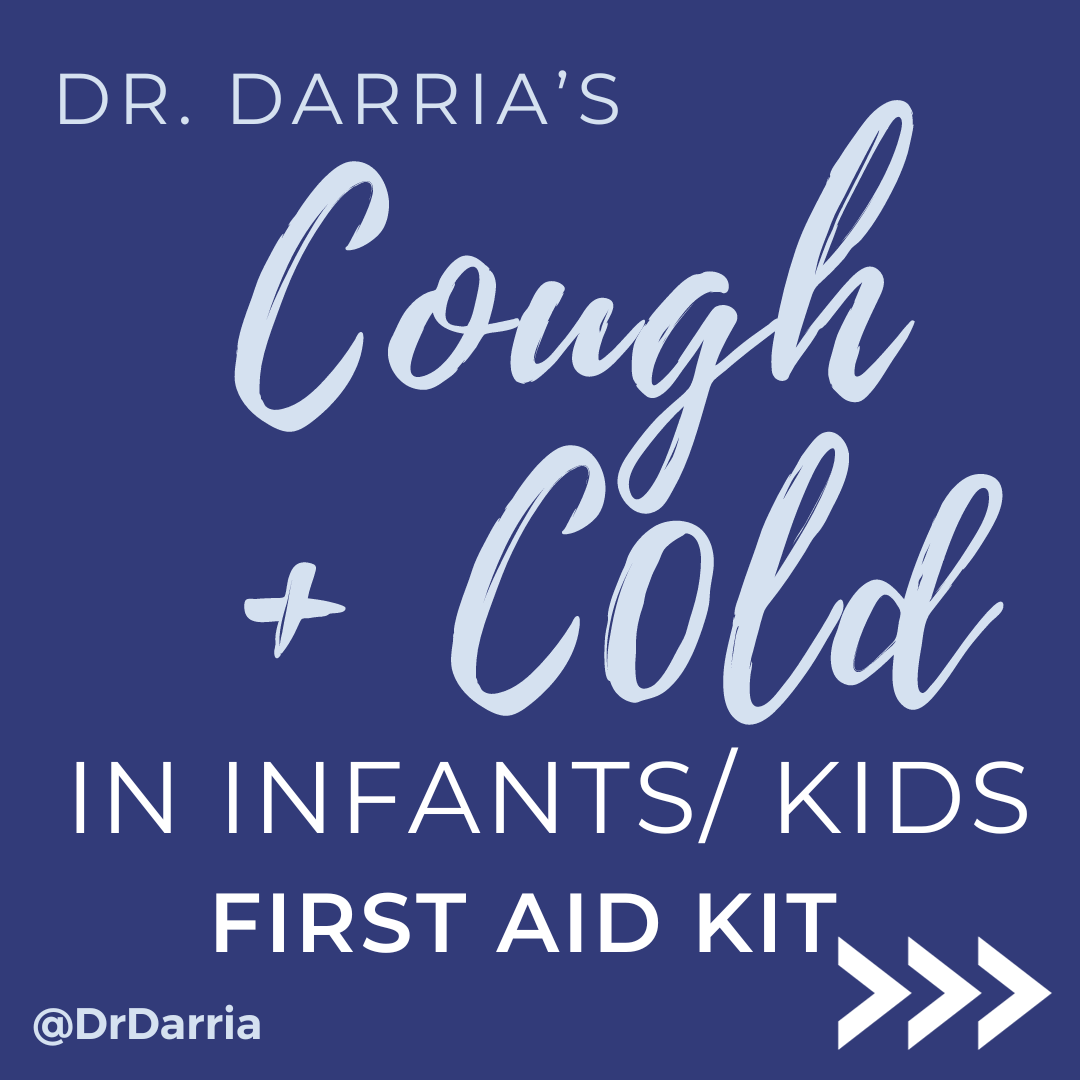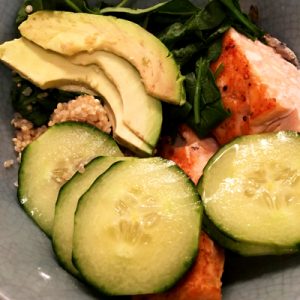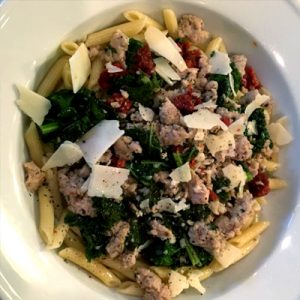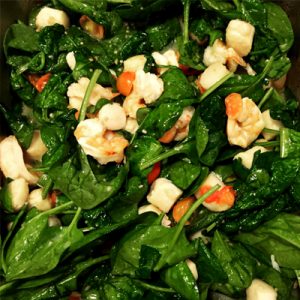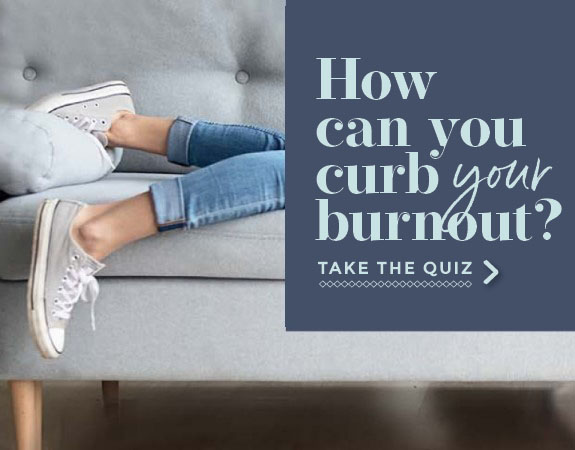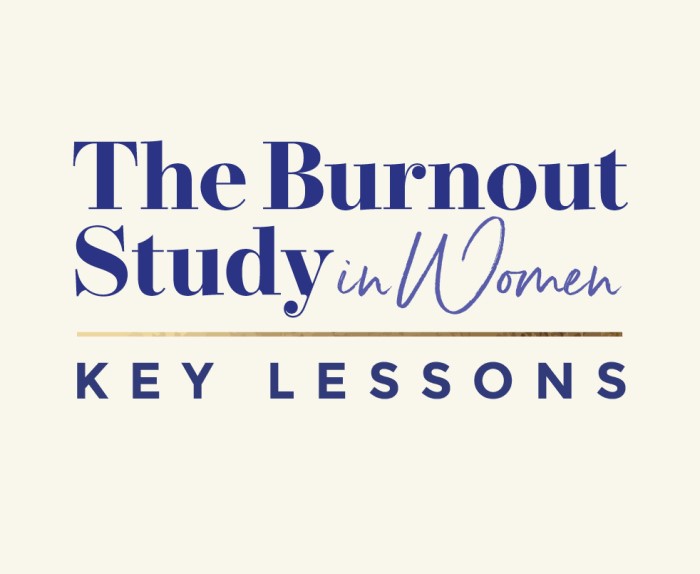Got a sick kiddo? Let's make it easier to get them feeling better ASAP - and for you to know what to do.
Because a sick kiddo is stressful enough – you don’t need to be googling for answers, too.
Guide Outline:
- Why do we GET fevers – and how long can we expect symptoms to last?
- Tips/Guidance by age:
- Cold/Flu/Fever Meds (What to give them to help)
The Science behind fevers and symptoms
(1) HOW LONG SHOULD WE ACTUALLY EXPECT SYMPTOMS?
Part of what worries many parents, are “should this be lasting this long”? I love this graphic of duration of symptoms – it’s a classic – but one of the best I’ve found for helping us all know what to expect, when, during colds and other respiratory viruses.
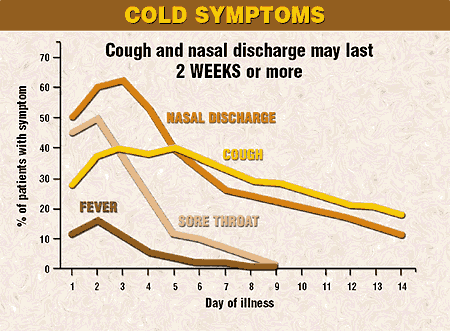
Graphic source: JAMA (It’s an old one, but after talking with many doctors and seeing thousands of patients myself, the pattern stands).
This graphic demonstrates:
- In the first 2-3 days, the body is mounting an immune response to fight off the infection. The fever is a sign that it’s happening.
- This highlights how the symptoms of a respiratory infection, especially cough and runny nose , LAST. In fact, 10-14 days of these symptoms are the norm rather than the exception – and NOT necessarily a sign that something is wrong.
(2) WHY DO WE GET FEVERS, ANYWAY?
When we have an infection (or some other causes), our body makes a fever – scientists are still learning the full purpose, but have learned that a fever itself is actually useful (not just a by-product of the immune response). Reasons include:
- Pathogens (such as viruses and bacteria) have their own thermometers – and when the temperatures are high, they are less likely to express specific genes that help them attack the body.
- In our own bodies, fever makes it harder for infections to get into cells, and to replicate. It also helps some of our immune cells function better
Of course, fever also comes at a cost
- For every increase in 1 degree, that requires our body to expend energy – just like going for a run. It also on OUR end, decreases specific enzymes, and affects our own metabolism.
- That’s why, the fever itself, can also make us feel crummy – and sometimes why we need to lower the fever.
For those reasons, when talking about a fever, we don’t react based just on the NUMBER alone. It’s a balance – of allowing the fever to do its job, while not letting it get so bad, that it harms the HOST, or the person infected.
Infants - 3 months and younger
how to take a temperature in babies
Red flags / when to see a doctor
Any infant 3 months or younger with a temperature of 100.4 or higher is an automatic call to your pediatrician and check-up. (Even if they don’t appear sick to you).
- Should you treat baby’s fever: Not without first talking to your doctor and only giving if they recommend.
- Why we have to take fever in newborns so seriously: In newborns, they’re far less able to fight off infections, it’s easier for infections to spread, and they also may not show signs of serious infections until they’re very advanced. That’s why any fever in a young infant requires urgent check-up and often labs and other tests.
- Video: Protecting Your Newborn
Children Older than 3 months
Once your kiddo is older than 3 months, we can breathe a sigh of relief, because infections do not present as high of a risk as in that newborn stage!
HOW TO TAKE A TEMP IN OLDER INFANTS / CHILDREN
- Video: What thermometers I use at home
- Infants and toddlers: Rectal
- Older toddlers and children:
- Oral (axillary or armpit also an option)
- What about other sites? Axillary (armpit) is always lower than rectal (core) temperature, which is why we don’t use it if the kiddo’s really sick and we need an accurate temperature. Ear (Tympanic membrane) temperature *may* be closer to core / rectal, but thermometers on the market are SO variable, you can’t consistently rely on it.
fact: you do not need to treat every fever
A fever is the body’s natural reaction to an infection + a sign that immune cells are at work.
So, we treat the CHILD – not the NUMBER. If kiddo is running around, playing, drinking fluids and just doesn’t really seem bothered, we can often just let their body do its thing.
We treat when:
- Kiddo is really miserable (fevers can make you feel like crap + lowering the fever can take a child from just lying around to acting like their normal rambunctious self).
- Refusing to drink fluids. A fever increases fluid loss, and can make children also just not even feel well enough to want to drink fluids, both of which increase their risk of dehydration
- If they have bad pain (like from a sore throat / ear ache)
RED FLAGS FOR WHEN OLDER INFANTS / KIDS SHOULD SEE A DOCTOR
The absolute number matters less – if your child exhibits any of these signs, get checked out (regardless of the level of fever)
- Age: Younger than 3 months old and has a temp > 100.4
- Symptoms: Have difficulty breathing, seizures, an unusual rash, stiff neck
- Behavior: They’re lethargic / way more tired than normal (even after fever medications brought down their fever – if they’re still behaving this way, definitely want to get them checked), inconsolably crying, or “just not themselves” (which is a mama gut feeling / my 6th vital sign!)
- Timing: A fever that doesn’t improve after 3-5 days (or fevers that keep coming back)
- Some numbers: if < 3 months and T > 100.4. If 3-36 months, and temp > 100.4 for > 3 days, or if their T > 102. Or, older children with an oral or rectal temp of 104 or higher
- Medical history: If your child has chronic medical problems
- Your gut telling you something is wrong. When a parent says “I know my child and they’re just not behaving like themselves”, that’s my 6th vital sign. If you’re feeling that way, come see us
COLD + FLU MEDICATIONS
WHERE TO BUY ITEMS MENTIONED HERE?
To save you a trip to the store (and trying to search for them), find these here:
My Infant / Child Cold + Flu Must-Haves
My Adult Cold + Flu Must-Haves (because parents get sick too…)
WHY CAN'T YOUNGER KIDS TAKE COUGH MEDS?
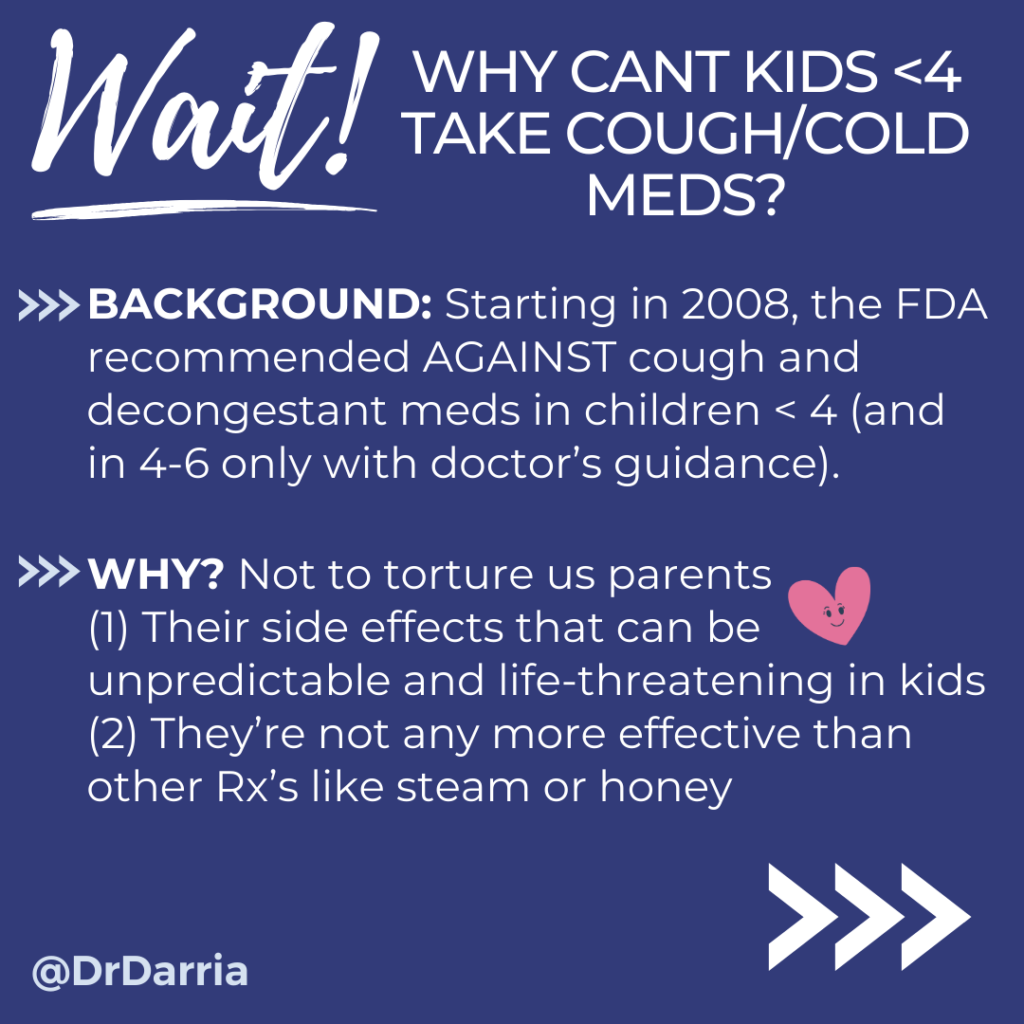
Science note: in children who aren’t able to blow their noses or really effectively COUGH, you don’t want to suppress the cough reflex / make it harder for them to cough up mucus.
WHAT I RECOMMEND TO HELP KIDS FEEL BETTER
- Fluids: Keep children well-hydrated. You can tell this by their urine output, if they have sunken eyes, and if their tongue or eyes appear more dry, instead of a moist sheen. You can also encourage soft foods, such as pudding, popsicles, chicken soup, jello, and ice cream
- For pain / fever:
- NOTE: You do NOT need to treat every fever. A fever is the body’s natural protection – so it’s ok to let it do its thing and fight off illness. That said, if it’s just making you feel AWFUL (especially enough so that you don’t want to hydrate), then that’s when I suggest treating.
- Video: Do you have to treat every fever?
- DOSING Guide: Fever / Pain medications
- VIDEO: The difference between infant / childrens versions of pain and fever meds
- Acetaminophen (Tylenol) every 4-6 hrs for pain or fever. (NOTE: infant and children acetaminophen have the SAME concentration).
- Pro tip: For infants / young toddlers, getting them to take liquid medications can be a challenge. In that case, Rectal Acetaminophen (in the first aid kit above) can be a lifesaver.
- Ibuprofen (Motrin or Advil) every 8-12 hrs for pain or fever (NOTE: infant and children Ibuprofen have DIFFERENT concentrations)
- Naproxen (Aleve) every 8-12 hours
- Chloraseptic Throat Lozenges: These contain menthol, which can help reduce coughs and open up clogged nasal passages. They also contain benzocaine, which is a topical anesthetic and not only helps a sore throat, but also can reduce a dry cough.
- For cough or congestion: Nasal clearing/Suction
- SO MUCH of kiddos coughing is due to nasal congestion. If they’ll allow you to do a nasal spray and/or suction, it has a huge impact.
- For infants, saline nasal drops and nasal suctioning can be extremely helpful and is the most beneficial intervention. You can also do this in order children, or just use saline nasal sprays and then have them blow their nose
- Remember, babies are often nose breathers. Unlike adults, who recognize that they should breathe through their mouth when their nose if clogged, babies don’t understand this, so can have more difficulties from a stuffed nose, making it even more important to try to suction out the mucus from their nose when possible.
- Saline sprays: spray ample amount into nostrils, then blow out until you are able to clear congestion
- NeilMed Nasal Wash System: Similar to a netipot (below), but comes with premesasured salt packets and bottle, to make this really easy to use for ALL ages. Few drugs in the world can work as well as just washing out the nasal passages!
- Neti pot: accomplishes same as saline sprays, more effective (people swear by it), but some people find it uncomfortable – would require an older and cooperative child.
- For cough or sore throat: Honey: ½ tsp of honey to children ages 2-5, 1 tsp for 6-11, and 2tsp for >12yrs. Don’t give to infants younger than 1 year. (in studies, found to be more effective than cough suppressants, and also doesn’t have the side effects).
- Can purchase as either just regular honey from the store, although some note that dark (buckwheat) honey is most effective. (Don’t stress over that one – just give regular honey if that’s all you can find). Zarbees also includes honey, but I just give them the regular grocery-store honey.
- For congestion or cough: Cool mist Humidifier: A 2004 study of 319 patients showed that inhaling warm vapor reduced symptoms by 31% and decreased nasal congestion, and sleeping with one in your room can reduce congestion and coughing. Regardless, make sure that you clean it regularly, so you’re not spreading mold and mildew! Do not use hot water in vaporizer, and make sure to empty the water after every use to avoid growing mold, which would only worsen their breathing.
- For congestion or cough: Shower steam: Turn on the shower as hot as possible (don’t get in), and let it really steam up your bathroom. Hang out in there for 15 minutes or so, to allow the humidity to help clear out your airways.
- For sore throat: Salt Water Gargle: My mom used to make me do this – I swore she was just torturing me. But a saltwater gargle can actually relieve pain and inflammation. To truly make a “hypertonic” solution, combine at least 1/4 teaspoon of salt in a half-cup of warm water, gargle, and spit.
- For cough: Vicks Vaporub (in children > 2, and also use judiciously – this contains camphor, which can be extremely toxic to children if swallowed)
NAUSEA REMEDIES
- Ginger-based Lozenges and gums: Ginger is a natural nausea remedy
VITAMINS / HERBAL REMEDIES
- Zinc: The evidence for Zinc isn’t conclusive, but it’s strong enough that I take it and recommend it. A recent research paper found that if Zinc is taken within 24hrs of onset of cold symptoms, it significantly reduced the duration and severity of symptoms.
- ALWAYS take these supplements with food, as this can make you really nauseated.
- Avoid intra-nasal forms (On which the FDA put a warning due to disruption of smell).
- For other supplements, vitamins, and lifestyle changes that can help, read my post here.
OVERALL
Overall, remember that viral infections typically last 7-10 days, which is how long it takes our immune system to recognize and fight them. In the meantime, help your kiddo stay hydrated, rest when they can, and take these medications as needed for symptom relief. Not getting better or meet any of the “Red flag” criteria above? Time to go check with your doctor.
All my best,
- Dr. Darria

